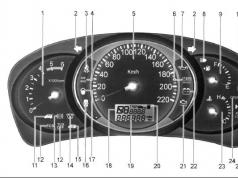When changing tires, the question often arises with the dimension of the tires available for a particular car model. This is due to the fact that the diameter of the tire and its width must be within certain limits allowed by the car manufacturer. Most often, the latter places this information in the operating manual or on the gas tank cap. Even with minor deviations from the recommended standards, fuel consumption increases, and the accuracy of the speedometer decreases. If the selected size significantly exceeds the recommended size, the risks of emergencies increase significantly.
Disc width calculation
145 155 165 175 185 195 205 215 225 235 245 255 265 275 285 295 305 315 325/30 35 40 45 50 55 60 65 70 75 80 85 R 12 13 14 15 16 17 18 19 20 22
Disk parameters (in inches):
Tire calculator for converting inches to mm
Conversion of inch tire size:To simplify the determination of the tire size, a special tire calculator has been developed, which allows the user to dispense with the need to decipher the numerical values on the side surfaces of the rubber. With the help of such a calculator, the difference in tire sizes, profile height and other parameters is determined. In addition, such a calculator allows you to receive other related information, for example, on the deviations of the speedometer, changes in ground clearance, and so on.
Purpose of the Visual Bus Calculator
The visual calculator allows every car owner to easily determine the size of the tires and the width of the required rims. With its help, it is possible to determine the diameter of the wheels, the error of the speedometers, an increase in the road track and changes in the clearance under the bottom of the car. Using a tire calculator, it is extremely easy to determine the optimal size suitable for a particular car model. The built-in size conversion system allows you to instantly convert values from inch to meter and vice versa.
It is advisable to use the potential of the calculator in cases where the car owner switches to using tires and wheels that are different from the original size. It allows you to visually determine the main dimensions, and then simulate them for the selected vehicle. In turn, the selection of tires with its help is impossible, since initially it does not provide for division by manufacturer.
Selection and comparison of tires according to the calculator 2.0
If new wheels and tires of a different size are installed based on the data received from the calculator, it is advisable to additionally carry out a number of measurements. It is advisable to determine the distance on the inner side between the wheel and the suspension, as well as from the tread to the shock absorber cup. In addition, you will need to measure the distance between the tread, fender and steering rods.
In turn, when choosing new tires, it is necessary to proceed from the advisability of a slight deviation in the geometric dimensions of the new tires from the previously used ones. The significant size of the dimensions will cause instability in the movement of the car.
Each car is initially created for certain parameters and dimensions. This fully applies to the permissible size of the used disks and rubber. Correspondingly, the selected rubber models must be within the established limits. The use of a tire calculator allows you to simplify the selection process as much as possible, depending on a specific vehicle.
Russians have to regularly face the replacement of rubber, primarily seasonal. The simplest solution in this situation is to use rubber of the same size. While maintaining the dimension of the rubber, the wheel will also retain its original dimensions.
In cases where rubber of a different size is selected, the selection of appropriate disks is required to obtain a wheel with the required dimensions. At the same time, by changing the standard tire sizes, it is possible to control the driving characteristics of the car, giving it additional softness or stiffness. The higher the profile used, the softer the vehicle feels on the road. As the profile decreases, stiffness increases, and narrow tires provide more grip on snow-covered surfaces, so they look more advantageous on winter roads.
At the same time, when selecting the dimensions of tires and wheels, it is required to adhere to the permissible dimensions. For example, tires that are too wide will touch the wheel arches in motion, rubbing them, and wear intensively on their own. It is also worth taking into account the fact that changing the size of the wheels affects the operation of the speedometer, in particular the magnitude of the error.
From the outside, it may seem that the variety of available configurations significantly complicates the calculations, but the bus calculator greatly simplifies the selection process using 3D modeling. The correct selection of tires is not only the necessary safety, but also the optimization of the road capabilities of the car. At the same time, the presence of the metric and inch system of sizes allows you to work with both American and European standard sizes without problems.
What is a tire calculator for:
With this tire calculator, you can easily calculate how the outer dimensions of the wheel, the height of the ground clearance (clearance), the speedometer readings and other characteristics will change when you install tires with a different standard size on your car.
Old tire size
Width
Height
Diameter
New tire size
Width
Select 5.0 5.5 6.0 6.5 7.0 7.5 8.5 9.5 10.5 11.5 12.0 12.5 13.0 13.5 14.5 125 135 145 155 165 175 185 195 205 215 225 235 245 255 265 275 285 295 305 315 325 335 345 355 365
Height
Select 25 27 30 31 32 33 34 35 38 38.5 40 45 50 55 60 65 70 75 80 85 90
Diameter
Select 12 13 14 15 16 16.5 17 17.5 18 19 20 21 22 23 24 25 26 28 30 32
First enter the standard size installed on your car, and then the one that you want to install.
The difference in speedometer readings and real speed depends on the speed of the car, the higher the speed, the greater the difference
| External dimensions | old | New | Difference | ||
|---|---|---|---|---|---|
| Tire width, mm (A) | 0 | 0 | 0 | ||
| Profile height, mm (B) | 0 | 0 | 0 | ||
| Disc diameter, mm (C) | 0 | 0 | 0 | ||
| Outside diameter, mm (D) | 0 | 0 | 0 | ||
| Change in ground clearance, mm | 0 |
On the website of the online store, the site contains a convenient tire calculator that allows you to easily calculate the changes in wheel parameters when switching to a different tire size. With this online tool, you can calculate the outer measurements of the wheel, ground clearance (ride height), calculate the speedometer readings and other characteristics.
With the onset of the new season, every responsible car owner considers it necessary to change the tires in accordance with the season. The best option would be to install tires of the size recommended by the automaker for a particular car brand. In cases where this is not possible, deviations in diameter in the 2% range are allowed.
Replacing rubber requires a serious approach. When choosing new tires and wheels, it is necessary to take into account such indicators as:
- tire width,
- profile height,
- inner diameter of the wheel,
- permissible speed indices.
Incorrectly selected tires can cause malfunctions in the car electronics, increase fuel consumption, deteriorate driving comfort, and also cause problems during a vehicle inspection at the traffic police.
How to calculate tires?
To find the correct tire size, you need to use a tire calculator, with which the theoretical dimensions are determined. All measurements are carried out in millimeters, and the speed in km / h. To make a calculation, you must enter the parameters of the tires of your car in the appropriate line. Then enter the dimensions of the new tire and the rim to be installed. After specifying all the parameters in the table below, information about changes in the width of the tire and the height of the profile, the inner and outer diameter, the difference in speed (real and according to the speedometer readings) will appear.
What to look for when choosing a tire
- Installing tires and wheels of non-standard sizes can damage the tire itself, damage the wheel and reduce the performance of the car. When choosing a rubber, it is better to rely on the recommendations of the automaker.
- If the diameter of the wheel rim is larger, then the load on the suspension may increase. To maintain the same diameter of the outer wheel, the profile height indicators should be reduced.
- If you choose tires with a greatly increased profile, you need to be prepared for a loss in the quality of vehicle handling. The tire can rub against the body and suspension, causing rapid wear.
- Even with the smallest difference between the indicators on the speedometer and in reality, the error can increase significantly with increasing speed, which makes driving unsafe.
- Narrow or too wide rims can deform the tire. This, in turn, will lead to premature wear and poor performance.
Instructions
Look at the nameplate in the driver's side doorway for the recommended tire size. Write it down on paper or memorize it. Find wheels of this size in a car dealer and use a tape measure to measure the outer diameter of the tire. Write this value down on paper. Drive the car into a hole and turn the front wheels out completely: first in one direction and then in the other direction. Measure with a ruler or tape measure the distance from the tire to the nearest structural member and write these values down on paper.
When choosing your favorite tires, consider the diameter of the future rims, and, depending on the size of the future tire, choose the width of the rims. The required disc width is equal to the tread width. It may be easier to find a disc with a slightly larger diameter and the desired width. For example, take rims of 14 inches instead of 13 and pick up tires on them. This option will be even more advantageous in terms of durability, but at the same time more expensive.
Try to buy tires that are approximately the same dimensions as the recommended ones. For example, the manufacturer recommends tires with dimensions 175 / 70R13 86S. 175 is the overall width of the tire in millimeters, / 70 is the height of the tire's profile as a percentage of the width, R-13 is the mounting diameter corresponding to the diameter of the discs, 86 is the load factor, S is the speed index. It is worth noting that the overall width of the tire may differ from the tread width, so if you want a wider tread, then pay attention to this feature. Do not use tires with reduced load and speed ratios.
If you want to put R16 wheels instead of R13 on your car, find a rubber of a suitable width. Since 175mm R16 tires do not exist, it is more realistic to find 215mm and wider tires. Look at your notes and calculate how many centimeters you have left. Increasing the tire width by 1cm more than the recommended one reduces the measured distance between the wheel and the body by 5mm. Please note that it is not advisable to increase the wheel diameter by more than 3 cm, as this will lead to increased fuel consumption and a deterioration in the traction characteristics of the machine. Select suitable tires and measure their diameter with a tape measure. Compare with the recommended wheel diameter. If the excess of the recommended dimensions of the future wheel is within the limits of your calculated norm, you can safely buy the selected tires. The speed and load factor in this case will significantly exceed the recommended one, which will have a beneficial effect on the durability of the rubber.
| 135 145 155 165 175 185 195 205 215 225 235 245 255 265 275 285 295 305 315 325 335 345 355 365 375 385 395 | / | 25 30 35 40 45 50 55 60 65 70 75 80 85 90 95 100 | R | 12 13 14 15 16 17 18 19 20 21 22 22.5 23 24 |
|
New tire size |
||||
|
CM INCH |
| Index | Old | New | Difference |
|---|---|---|---|
| Diameter | 505 mm | 586 mm | +81 mm (+ 16%) |
| Width | 155 mm | 205 mm | +50 mm (+ 32%) |
| Circumference | 1587 mm | 1841 mm | +254 mm (+ 16%) |
| Profile height | 62 mm | 103 mm | +40 mm (+ 65%) |
| Revolutions per km | 630 | 543 | -87 (-14%) |
| Change in clearance | The ground clearance will change by 41 mm | ||
| Result: |
The diameter differs by more than 3%. This is dangerous!!! |
||
| Refresh your browser 100% |
Refresh your browser 100% |


When choosing new tires for your car, first of all, you need to find out whether the copies offered by the seller are suitable for the parameters of a particular car. It is easy to make such calculations if you use the free online visual tire calculator 3D in the KAMTECH online store.
We offer you a wide selection of tires and rims for cars of various brands and models, and with the help of our best tire calculator you will quickly find your way and be able to make the right choice.
How to use a tire-disk calculator in the KAMTECH online store?
Take a few simple steps: select the standard size of your car, as well as the sizes of the new tires (rims) that you wish to purchase. Then click the "calculate" button. You will see the difference between tires (disks) and deviations according to various indicators: diameter, width, circumference, profile height, and so on.
If the visual online tire calculator 3D showed a discrepancy between the parameters of tires and wheels for the car brand, you should choose another model. Installing tires that are not recommended by the manufacturer can lead to improper operation of the speedometer, odometer or other electronic systems of the car (for example, ABS, EBD and others). Also, the handling characteristics of a car may deteriorate, which is quite dangerous, especially in winter.
If you install tires with a profile less than the standard one, the ride stiffness will increase, the driving comfort will decrease, and the load on the suspension will increase.
In other words, the usefulness of a tire calculator by car brand cannot be overestimated. It will save you time on the selection of tires and wheels, will not allow you to make the wrong choice and waste your money. Come to KAMTECH.RU - choose the right tires and buy them at a low price.
With the help of a tire calculator, you can easily calculate how the outer dimensions of the wheel, the height of the ground clearance (clearance), the speedometer readings and other characteristics will change when tires with a different standard size are installed on your car. The calculator calculates all tire sizes in millimeters, and the vehicle speed in km / h.
And also the calculator will help to calculate the required rim width for a specific tire size.
How to use the tire calculator:
First enter the standard size installed on your car, and then the one that you want to install and click "calculate". The table on the right shows the results of the calculator's calculations.
Detailed information on tire marking in the section: tire marking.
We recommend that you only install the factory tire sizes that are specified in the operating instructions for your machine. Installation of non-standard sizes may void the dealer's warranty, as well as impair the performance and handling of the vehicle.
Tire calculator for European tires
Old size:
New size:
145 155 165 175 185 195 205 215 225 235 245 255 265 275 285 295 305 315 325
/ 25 30 35 40 45 50 55 60 65 70 75 80 85
12 13 14 15 16 17 18 19 20 21 22 23 24
Found in the directory:
175/70 R13 -
175/70 R13 -
When converting tire sizes on a calculator, keep in mind that:
With an increase in the diameter of the rim (and, as a consequence, a decrease in the height of the tire profile, so that the outer diameter of the wheel remains unchanged), the load on the car's suspension increases, and comfort also deteriorates (the car will become noticeably stiffer).
With an excessive increase in the profile of the tire, the car becomes a "roll", it is less controlled and at critical values of the height of the profile, the tire can begin to cling to the parts of the body and suspension of the car, which will subsequently lead to its destruction.







